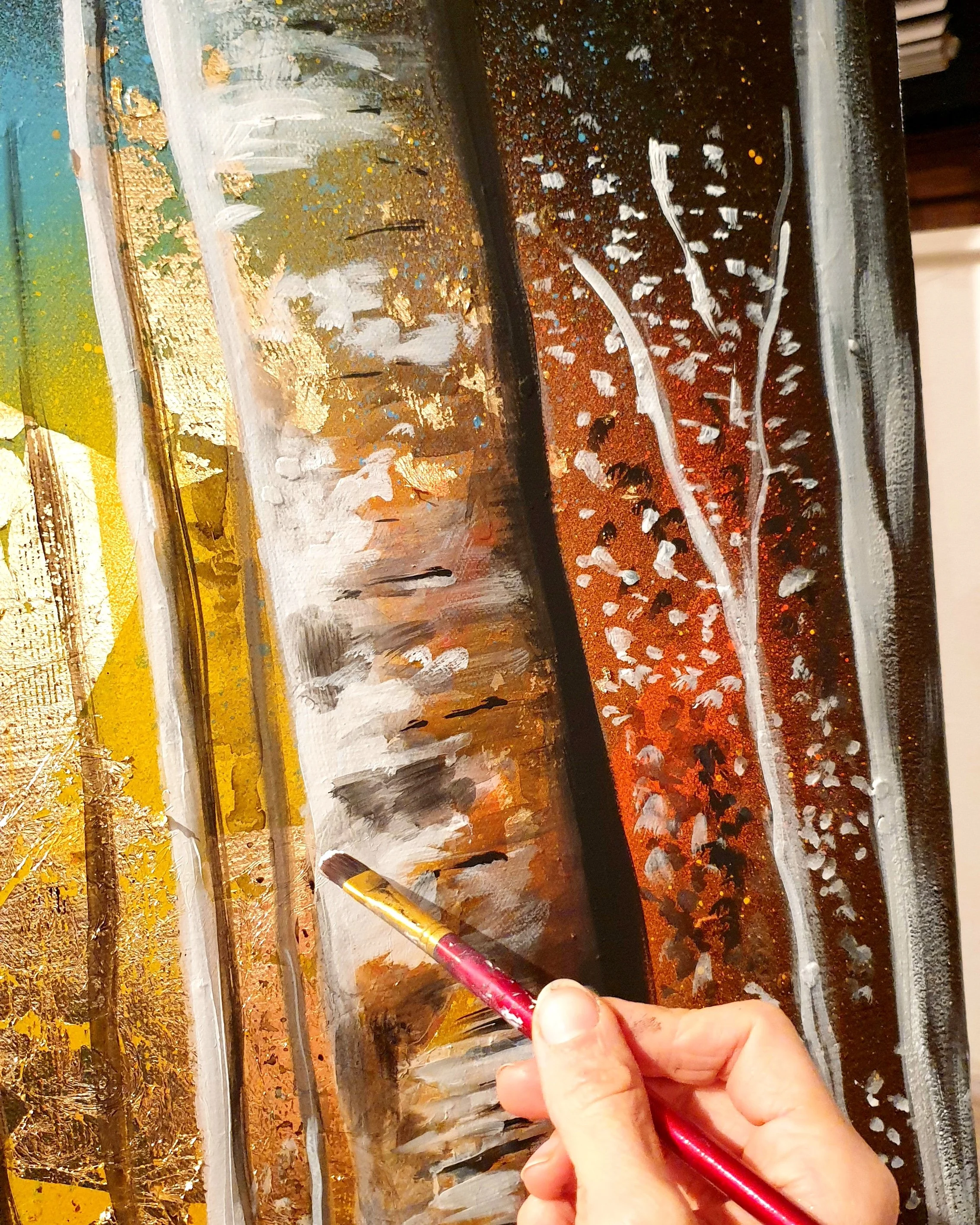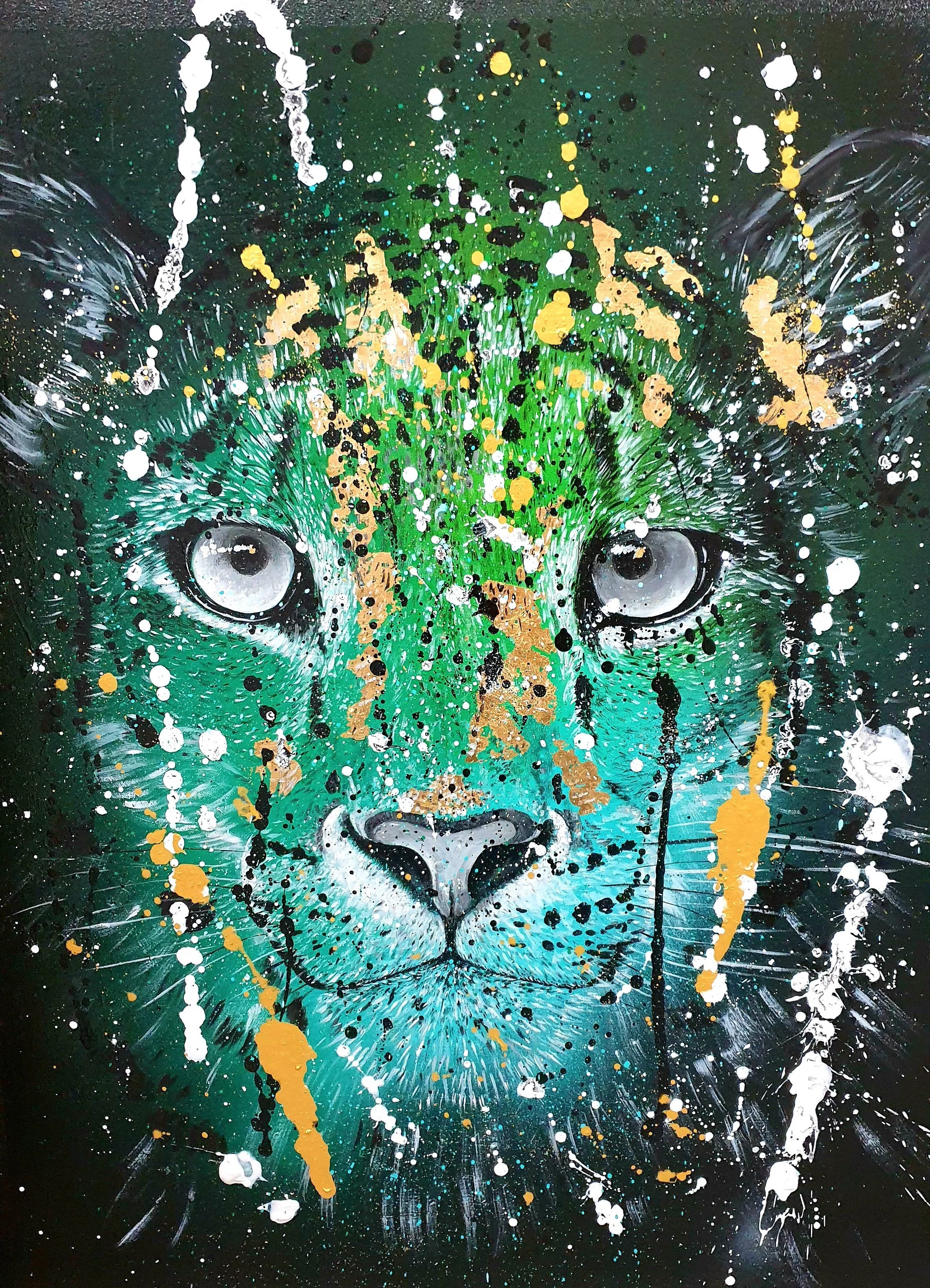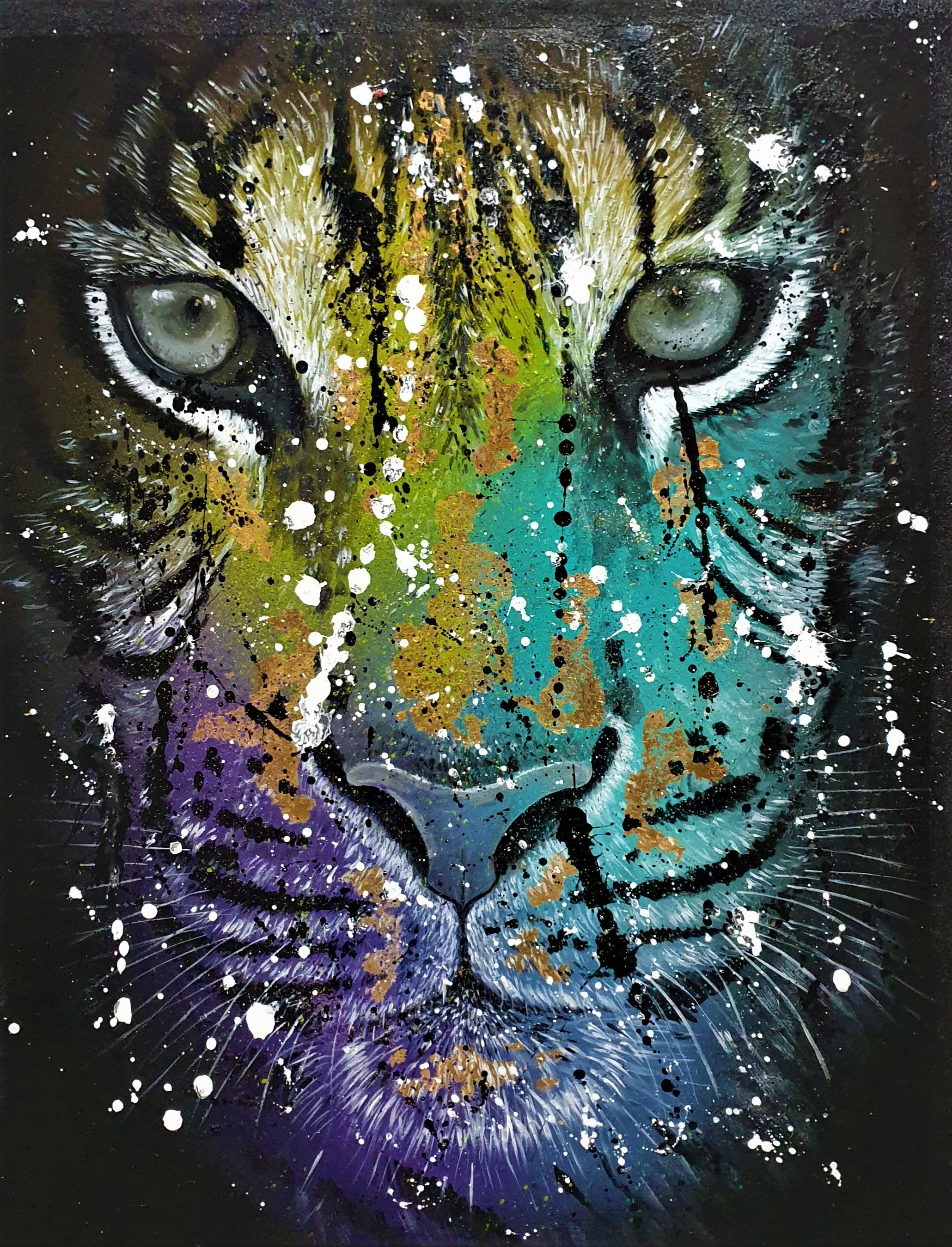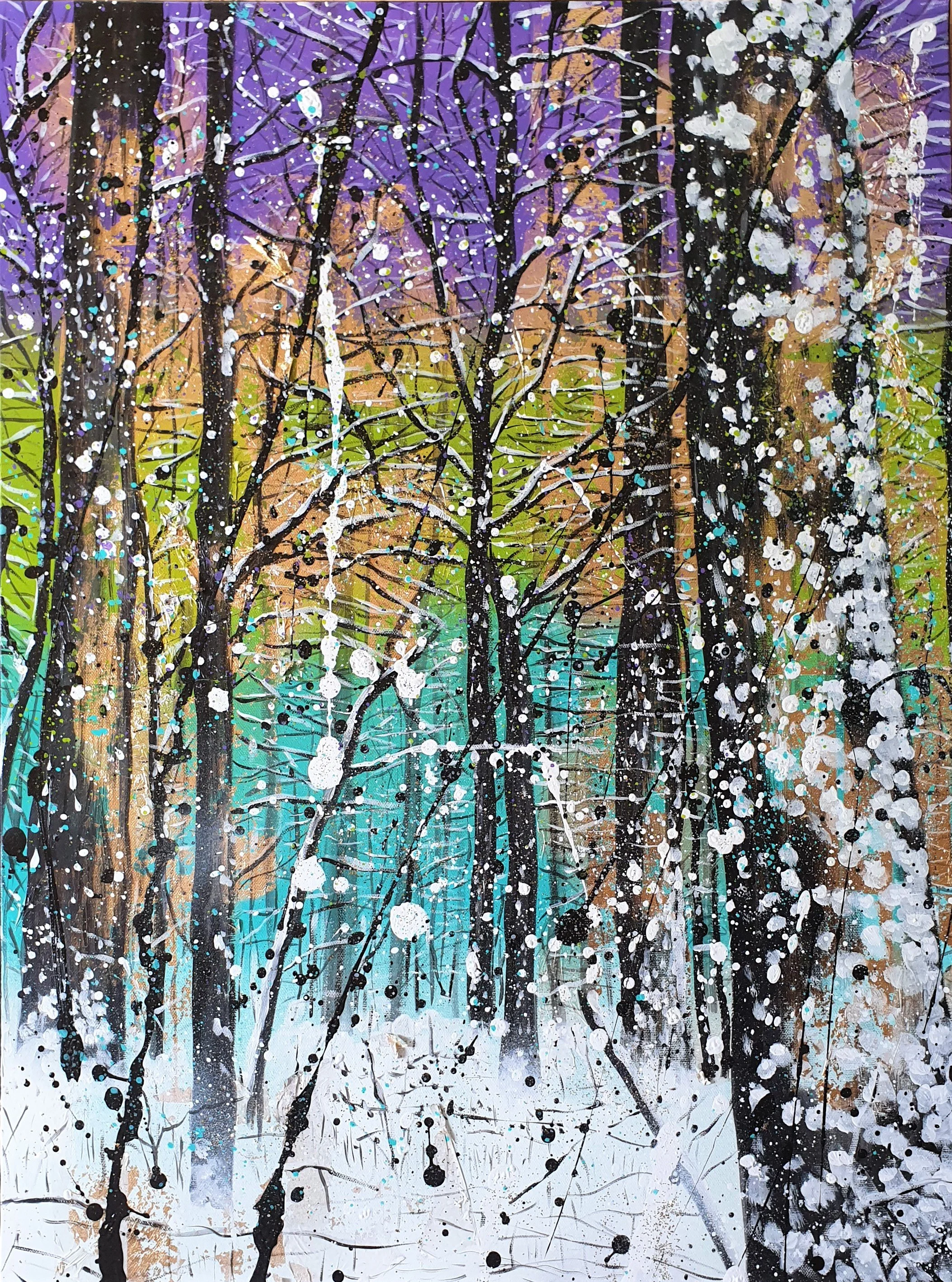Interview with Rosie Tretter
Rosie Tretter is german artist living near Stuttgart in the south of Germany. In her colorful artwork, using acrylic paints & acrylic spray in combination with gold leaf, varnish & diamond dust , she expresses the beauty, uniqueness & at the same time transience and destruction of nature & wildlife. She wants to inspire people to protect and save our singular planet, before some species possibly disappear forever.
„Perhaps the motivation to protect our paradise is higher when we focus on the beauty of nature“
Rosies paintings are like snapshots of a world that’s as breathtaking as its fragile. Her art is not just about pretty pictures, it’s a love letter to nature and a mission as colourful as her palette with a style that’s part realism and part abstract.
“For me, art is freedom. Reality and fantasy meet and merge into a new world. Both the artist and the viewer can enjoy the freedom – the artist in his or her possibilities of expression, the viewer being able to interpret all of them.”
Rosie, you describe your artwork as a blend of reality and imagination that liberates the mind from conventional constraints. How do you navigate the tension between presenting nature as it is and as you perceive it might be? Can art truly capture or even enhance the essence of nature without distorting its fundamental truths?
I think art in particular brings out the essence of nature. When you look at a painting you often notice a lot more details than while being outside in nature. A picture stimulates the viewer's imagination and makes them consider. Looking at a painting can be at least as much of an experience as being out in nature.
However, a painting can only ever represent part of the truth. Of course, you can only experience the big picture directly in nature. And nothing, not the most talented artist will ever be able to compare with the unique beauty of nature.
I try to mix components of reality with inventions and want to awaken the viewer's imagination. When you look at my artworks you first might see an abstract, colorful painting but then you realize it’s not just strokes and splashes of paint, but trees and leaves, a forest. The viewer should ask himself, is there only one reality? Or doesn't everyone rather have their own reality of the nature of things? You always see what you want to see.
As a self-taught artist, you've explored various painting techniques and styles. Could you describe a specific technique or artistic breakthrough that significantly transformed your approach to painting? How has this evolution impacted your representation of nature and wildlife?
After painting with watercolors and oils for a long time, I came to acrylics. I love the power of these colors. The mixture of acrylic paint and acrylic spray and experimenting with unconventional colors gave me the opportunity to depict nature and animals in the splendor of colors in which I perceive them.
The use of gold leaf brings the desired effect of perfection and eternity of nature into my pictures. The finish of gold and diamonds dust contributes to the nobility of the subject, emphasing that everything ultimately turns into dust.
I want to represent my subjects as a contrast between death (motif in black/white) and life (colorful background), as well as transience (dissolving color) and eternity (gold).
Having traveled extensively as a flight attendant and experienced diverse landscapes and cultures, how have these global influences manifested in your art? Can you pinpoint any particular experience or destination that has left a lasting imprint on your artistic style or thematic choices?
Observing our planet from a few kilometers above, you gain an understanding of the natural masterpiece we inhabit, despite its fragility.
My time travelling the world had a huge impact on me, both personally and on an artistic level. I went to art museums at every opportunity, walked through cities, and always went into the surrounding nature and literally absorbed all the impressions. I just wanted to save as much of the experience as possible so that one day I could process it on canvas.
When I think back of certain places, there is always a memory of colors. For example, in South Africa, despite high poverty level, people were always brightly dressed up expressing a tireless of joy. This vibrant cultural expression in even the poorest places left a lasting impression on me. When I think about Cape Town today, there is still a memory of yellow, blue and purple in my head. It almost seems like the poorer a nation, the more life-affirming they are. Very imposing!
As you can easily see, I was particularly impressed by the wildlife in Africa. You know all these animals from the zoo. But seeing a lion in the wild for the first time, looking straight into your eyes, is an event that never lets you go. The beauty of all those wild animals is just so powerful and reverent, almost impossible to represent.
You aim to use your art to spark a greater motivation to protect natural paradises. In your view, what role should artists play in addressing and advocating for pressing environmental issues? How do you measure the impact of your work in this regard?
I think each and every one of us should try to do something to protect our planet. But we need to remind and motivate each other. Anyone who has the opportunity to take a pioneering role should do so.
Art serves as a potent communicator of essential messages. The language of images is significant in signaling important statements without personal blame. I am sure, that art has the power to provoke and inspire change.
With showing endangerd species I hope to kindle a desire in people to contribute a portion of their wealth to projects dedicated to endangerd nature and animals. Let's support those who are already dealing with it and know what they're doing. There are so many marvelous, comitted people, but they also need our support. Even a small amount can make a change.
Your work emphasizes the transience of life and the importance of preserving memories of fleeting beauty. How do you choose which moments or aspects of nature to immortalize in your art, and what techniques do you use to convey this sense of fleetingness?
Basically, any subject qualifies here, as everything on this planet is temporary. I am particularly impressed and dedicated by animals that are threatened with extinction. I find it very sad how irrelevant this topic is. Imagine a world without various big cats or elephants - how depressing that would be! Hardly anyone knows, for example, that there are only about 7000 cheetahs left all over the world! This amount is ridiculous! Our focus is on war & violence, new viral diseases or finance crisis while the essential thing, the diversity of our nature, is disappearing and many species vanish quietly without getting noticed.
To present the sense of fleetingness I first create my scene or portrait in the most cheerful colors and then let it disappear into the black or colorful background, “destroying” it by paint splashes and acrylspray. The image of the animal thus dissolves into nothing or into the large black emptiness and all that is left are outlines.
Considering your profound connection to nature, how do you balance the authenticity of natural forms with the expressive colors and abstract forms in your art? Is there a particular element or aspect of nature that continually challenges or inspires you more than others?
Every artwork is another great challenge to present perfection and beauty of nature. Depicting nature in its true splendor is almost impossible. Nothing can measure with this only true genius.
On the one hand, the beauty of a tree, its structure, the details, is incredibly inspiring, but at the same time I have the feeling that I will never be able to do it justice. My motifs are always a mixture of bright colors and black drawings to represent the contrast between death (black) and life (colorful). For me, the world and nature have always been colorful. Colors are emotions and before I start with my artwork, I listen to my inner self to find out which feeling, means which color, I “experience” when thinking of a giraffe or a leopard.
Sometimes the presence of my object changes during the painting process and I have to adjust the colors, but in the end my motif is exactly as it appears to me emotionally.
You've mentioned the freedom viewers have in interpreting your artwork. What do you hope people feel or think when they encounter your pieces? Are there any interpretations of your work that have surprised or challenged your own understanding of what you've created?
I don't want to raise my fingers with my artwork and accuse anyone of being responsible for the disappearance of some species. First and foremost, I want to awaken an emotion in the viewer, attributes that the animal presences. I would love to have the viewer saying "wow, this tiger gives me an incredible amount of power." Only then he maybe thinks about statements, what the abstract or black background is about. In fact, a lot of people ask me what the destruction caused by paint splashes and acrylspray is all about, which often leads to interesting conversations and lots of "AHA" effects.
Someone once told me that I should choose either a realistic or abstract style in my paintings, both together wouldn't work. Why? Isn't that what constitutes art? That everything is allowed? Who determines what is real? Is reality perhaps completely different than we think it is?
This is what I mean by freedom of interpretation when looking at art. There is not only one truth in our world. The artist puts his truth on canvas, but it only becomes interesting through the viewer's many other truths. Art is just what the viewer sees in it.
And - for me the most important- really no one should be limited by the opinions of others.
Reflecting on your time in Namibia, which aspects of that environment have influenced your artistic narrative the most? Are there specific elements from that time that recur in your work, perhaps as motifs or themes?
I captured Namibia as soon as I got off the plane. No one who has a sense of beauty can escape this incredible expanse, the bare and at the same time so beautiful landscape. But what impressed me most was the wildlife.
One day I visited the CCF ( cheetah conservation fund), a cheetah rescue and breeding station. Only there I actually realized for the first time how endangered these impressing and unique creatures are and how important it is that great people like you find there work to protect them. That day I developed an urgent desire to support it in any way. As a child, I admired cheetahs on nature TV shows for their records and it was a shocking but also awakening moment when I found out that one day they could disappear from our planet.
Another horrific aspect was the current issue of poaching and also hunting tourism. When you hear hunters talking about their "successes" or see a dead rhino brutally slaughtered cause of its horn, you seriously start to doubt the sanity of the human species. This was the deciding factor for me to want to do something about it, the hope to stop all those mentally ill people.
Unfortunately, you often only become aware of something when you are confronted with it.
As someone passionate about protecting nature, how do you ensure that your art practice is sustainable? Are there particular materials or methods you favor to minimize your environmental impact?
On the one hand, I always try to get my materials from local dealers (apart from the ecological aspect, there is nothing nicer than strolling through an art specialist shop). If I no longer like an old painting, it is simply re-primed and painted over. So I never have to throw away my canvases. I try to produce as little waste as possible and save every material and all kind of deco that I could use again at some point.
Looking forward, how do you see your art evolving in the next decade? Are there new themes or techniques you are eager to explore, or perhaps a particular project or collaboration that you dream of realizing?
You are constantly longing to develop further, discover new materials, techniques and challenges. I still want to put all of my landscape images that I still have in my head and in photos onto canvas. As well I want to grow with my artwork sizes and paint enormous animal portraits on very huge canvases or maybe even house walls.
It would also be an important concern and a great honor to cooperate with nature conservation organizations; I have been envisioning an enormous portrait of a panda bear for a long time…
Actually, my biggest goal is to be able to achieve and support that our wildlife doesn't disappear. If I can help to protect our biodiversity through my art and manage to motivate someone to also support animal protection, I couldn't be happier.
https://www.rosie-tretter.com















